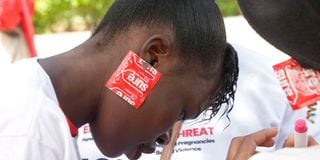Sh10bn funding gap hindering HIV fight

A woman wears an earring fashioned from a condom during celebrations to mark World Aids Day in Nanyuki last December.
Authorities say Kenya is grappling with a Sh10 billion HIV commodities funding gap due to increasing prices, re-basing of the economy to lower middle-income status and donor funding cuts.
This comes amid the Biden administration’s recent proposal of a $25 million budget cut to the President’s Emergency Plan for Aids Relief (Pepfar), which could affect Kenya.
Speaking to Nation yesterday, National Syndemic Diseases Control Council (NSDCC) Chief Executive Officer Ruth Laibon-Masha said Kenya needs Sh25.4 billion annually. She said that, while the number of people living with HIV has increased, there has been a disproportionate decrease in resources for procuring commodities.
“Donors have reclassified how they give us money and grants following rebasing of the economy to lower middle-income status. Kenya must fulfil an annual budget of Sh25.4 billion to provide lifesaving drugs to 1.29 million adults and children living with HIV,” Dr Laibon-Masha said.
According to the “People living with HIV and funding" report by NSDCC, the rising rate of HIV infections among Kenyan teenagers, which the Ministry of Health put at 42 per cent last month, presents a problem.
“In 2015/2016, the commodities funding gap was at Sh2 billion and widened to Sh3 billion in the 2016/2017 cycle after which the gap further widened to Sh7 billion and now, in the 2022/2023 cycle, we are grappling with a funding gap of Sh10 billion,” Dr Laibon-Masha said while noting that the devastating impacts of climate change are making access to HIV commodities worse.
According to the Global Health Council (GHC), climate change is the most significant threat facing humanity.
“Most emerging infectious diseases are the result of spill-over pathogens from animals to people. Examples of emerging infectious diseases with such zoonotic origins include HIV, Ebola virus disease and monkeypox,” GHC observes in the 2023 global health briefing report.
While agreeing with Dr Laibon-Masha, Elizabeth Glaser Paediatric Aids Foundation President Chip Lyons said he is concerned by the proposed $25 million in cuts to Pepfar.
“President Biden’s budget falls short of providing the appropriate funds needed to support the global HIV response and hinders the progress to be made in the fight against paediatric Aids,” said Mr Lyons, who is of the view that cuts to Pepfar put the hard-won gains in the global HIV response at risk highlighted.
“The world looks to the US for leadership in the fight for an Aids-free generation and the current budget does not offer the required resources needed to end Aids as a public health threat by 2030,” Mr Lyons added.
Last month, while officially launching Africa Reaching the End of Aids in Children and Youth in Africa by 2025 (Africa Reach) in Addis Ababa, Ethiopia, the Organisation of African First Ladies for Development pointed out the urgent need to address the lack of HIV commodities on the continent.
“We need home-grown action and care as new HIV infections among young people remain high and children are left behind in the HIV response”, said Ms Toyin Saraki, the CEO of Wellbeing Foundation and a World Health Organisation Africa region panellist said in her opening remarks on behalf of Africa Reach Leadership Council.
“Politics and politicians are there to solve our most complex problems but they cannot solve them on their own”, Ms Monica Geingos, the First Lady of Namibia and Africa Reach Leadership Council chair, said.
Last month, 12 countries leading the Global Alliance to end Aids in Children, including Kenya, together with community representatives, UN agencies, stakeholders and partners gathered in Tanzania to birth what is now known as the Dar-es-Salaam declaration to end Aids by 2030 as they deliberated on progress and plans to end the HIV pandemic.
Angola, Cameroon, Côte d'Ivoire, the Democratic Republic of the Congo, Kenya, Mozambique, Nigeria, South Africa, Tanzania, Uganda, Zambia, and Zimbabwe resolved to strengthen, coordinate and resource robust national programmes.
“Kenya has reaffirmed her commitment to ... ending HIV and Aids infections amongst children by the year 2030. We are using digital technologies in ensuring access to treatment and care to all pregnant and breastfeeding women and providing access to universal testing and treatment for all children and adolescents living with HIV,” Health Cabinet Secretary Susan Nakhumicha said.





